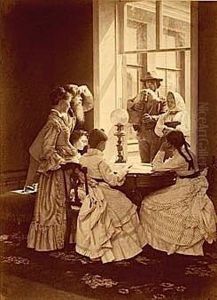Andrei Andreevich Karelin Paintings
Andrei Andreevich Karelin was a distinguished Russian photographer and painter, born in the city of Nizhny Novgorod in 1837. He was an accomplished artist known for his significant contributions to the development of Russian photography in the 19th century, particularly in the area of portrait photography.
Karelin came from a family with artistic inclinations; his father, Andrey Osipovich Karelin, was also a photographer and provided Andrei with his initial training. Karelin's artistic journey began with painting, but he quickly recognized the potential of the emerging medium of photography. He embraced this new art form and went on to master it, becoming one of the first Russian photographers to gain widespread recognition.
Throughout his career, Karelin combined his skills in painting with his photography work. He was known for his hand-colored photographs, which were a unique blend of the two mediums. This technique involved taking a monochrome photograph and meticulously adding color by hand, resulting in images that had the realism of a photograph with the artistic touch of a painting.
Karelin's studio in Nizhny Novgorod became a cultural center and attracted many prominent figures of the time. He photographed a variety of subjects, including Russian nobility, cultural icons, and ordinary citizens, capturing the social fabric of his era with sensitivity and depth. Karelin was also interested in documenting Russian folklore and peasant life, contributing to the ethnographic record of the period.
In addition to portrait photography, he was involved in producing photo albums and views of Russian cities, which were of great historical value. One of his significant works includes a series of albums documenting the crafts and trades of the people of Nizhny Novgorod, which he presented at the All-Russian Manufacturing Exhibition in 1870. These albums won him acclaim and awards, both domestically and internationally.
Karelin's work was characterized by a high level of technical proficiency and artistic expression, helping to establish photography as a respected art form in Russia. His legacy is preserved through his photographs, which provide a window into the life of 19th-century Russia.
Andrei Andreevich Karelin passed away in 1906, leaving behind a rich body of work that continues to be studied and admired by art historians, photographers, and enthusiasts of Russian culture.


